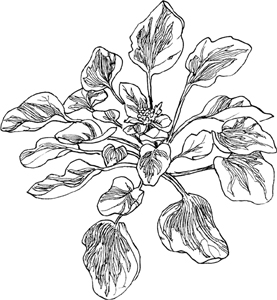
BOTANICAL NAME: Barbarea vulgaris
FAMILY: Brassicaceae

Old herbals and garden books are not very precise in their treatment of this charming old garden potherb. Normally, they lump several different species of mustards together under the general category of scurvy grass, since these vitamin-rich plants were once considered essential for staving off scurvy during the depths of winter. Another name is St. Barbara’s Cress, but again this common name could designate any one of three Barbaras: Barbarea praecox, Barbarea verna, or Barbarea vulgaris. Perhaps this did not matter to country people since all of these mustards could be employed in the same way and indeed looked very much alike. European winter cress, however, grows in a handsome rosette shape, with leaves resembling watercress. In taste, winter cress and watercress are almost identical, but winter cress is far easier to grow.
Seeds are generally planted in the late summer or early fall so that robust plants would develop in time for winter. They are often covered with straw around St. Barbara’s Day (December 4) to make access easier under deep winter snows, but frankly they do not require much protection, at least not in my garden. The leaves are then gathered for winter salads, eaten with cabbage, cooked in soups similar to watercress soup, and even infused in beer to make an antiscorbutic tonic for those suffering from vitamin C deficiency. They add an extremely beautiful touch to any sort of salad mixture and make a perfect garnish for Christmas and New Year’s roasts.
In 1827 a golden yellow variety was introduced and mentioned in Gardener’s Magazine in England, but it never really caught on outside of France. There is some disagreement over just how the variegated variety came about, for it could be either a cross between the golden and common green cress or a naturally occurring mutation in the pigmentation of the leaves of the common green variety. However it happened, salad lovers have doted on this beautiful cress at least since the 1840s. It has remained a popular winter ornamental in England and France, since its leaves are blotched in shades of green, cream, and golden yellow—as though dappled with a paint brush—and literally jump for attention along any garden pathway.
I first saw this variegated cress one rainy April day in England, huddled along among Labrador violets with their black-purple leaves and intense pinkish flowers in a friend’s thoughtfully designed kitchen garden. Behind this were clumps of golden feverfew with brilliant chartreuse leaves and Chinese violet cress (page 53) in full bloom, looking more like miniature pink poppies than the mustard it is. All of these plants are edible and make the most delicious spring salads. The cress of course suggested the next step. A few shreds of Profusion sorrel (page 179), a handful of Katie’s Mustard Lettuce (page 120), and one or two small heads of lettuce, along with a few poached, diced Roseval potatoes (page 210) more or less completed the dish. It made me think of John Evelyn and his 1699 book on salads and how jealous he would be to learn that this feast of greens was initiated with a dish of Channel whelks well doused in shallots and vinegar. After that, one can only move on to plaice and a good French wine.